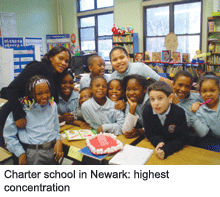America’s universities are the best in the world, but the kindest verdict on its schools is “could do better”. The country spends enough on them — around the rich-world average of 3.8 percent of its massive $ 13.8 trillion (Rs.66,739,000 crore) GDP — but its pupils do poorly in tests of reading, writing and mathematics, and too many drop out before completing school. Teaching attracts few ambitious and able graduates; school leaders have little autonomy. The solution, to free-marketers, seems obvious. Give taxpayers’ money not to a state-run monopoly, but to independent schools.
Since Minnesota started the experiment in 1991, most states have introduced independent, or charter schools in some form. Evaluations have been broadly positive, but their enemies, including the politically powerful teachers’ unions, can fairly claim that more research is needed. Do charter school pupils do better at tests because they have been coached intensively at the expense of a broad education? Do charters mean the most motivated students cluster in a few schools, to the detriment of the majority? Do they kick out — or coax out — the toughest to teach?
 The answers to such questions should soon become clearer. Newark, New Jersey, one of America’s grimmer cities, also has one of the country’s highest concentrations of charter schools and is on course to have more. Seventeen schools run by 12 charter-management groups teach almost a tenth of the 48,000 children in its public-school system; by 2015 that share is likely to double.
The answers to such questions should soon become clearer. Newark, New Jersey, one of America’s grimmer cities, also has one of the country’s highest concentrations of charter schools and is on course to have more. Seventeen schools run by 12 charter-management groups teach almost a tenth of the 48,000 children in its public-school system; by 2015 that share is likely to double.
That is turning Newark into a magnet for education policy wonks. The Newark Charter School Fund, established last year with money from, among others, the Bill and Melinda Gates Foundation, will help new schools navigate the bureaucracy, find buildings and recruit the best teachers. But it will also gather a mountain of data on the performance of every charter school, and pupil, in Newark.
Newark’s charters are convinced they have a compelling story to tell. “We have never expelled a single child from any of our schools in Newark,” says Ryan Hill, the director of the three schools run in the city by the Knowledge is Power Programme (KIPP), America’s largest charter chain. “Great teachers prevent problems from developing in the first place.”
Drew Martin, a KIPP principal, is proud of his school’s record in getting lagging children back on course. “More than four-fifths of our pupils were reading below grade level when they arrived aged ten,” he says. “Three years later, fewer than a quarter of them still are.”
Even if they are right, the debate will not be over. The final charge against schools such as those run by KIPP is that their longer hours and demanding work environments make them impossible to sustain, let alone replicate. Hill thinks part of the solution lies in better management and training. The KIPP schools with the best teacher retention are also the oldest, he notes, suggesting that, over time, school leaders work out how to make the job manageable.
League tables appreciation
Academics love to hate them, but university league tables can be a force for good, according to new research. A report by the US Institute for Higher Education Policy has found that rankings can foster collaboration, lead institutions to share best practices and prompt improvements in teaching and learning.
The report, Impact of College Rankings on Institutional Decision-Making: Four Country Case Studies, says that university ranking systems, although controversial, have become “an entrenched phenomenon around the world”. It identifies the annual Times Higher Education-QS World University Rankings and Shanghai Jiao Tong University’s Academic Ranking of World Universities as the two “most prominent” global systems.
It acknowledges there are “many valid criticisms” of domestic and international ranking systems, with some institutions placing “too much importance on their ranking position over other... practices”. But it adds: “Rankings can encourage institutions to move beyond their internal conversations to participate in broader national and international discussions.”
Ranking tables can also encourage partnerships between institutions, the report says. “Rankings are often perceived as instigators of competition among institutions, but case studies suggest that they also foster collaboration, such as research partnerships, student and faculty exchange programmes, and alliances. (They) can be important starting points to identify institutions with which to collaborate.”
The report also identifies direct benefits to teaching and learning. “Institutions that use their rankings to prompt change in areas that directly improve student learning experiences demonstrate that rankings can lead to positive change in teaching and learning practices,” it says.
(Excerpted and adapted from Times Higher Education & The Economist)